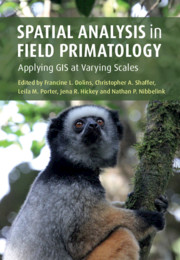Book contents
- Spatial Analysis in Field Primatology
- Spatial Analysis in Field Primatology
- Copyright page
- Dedication
- Contents
- Contributors
- Acknowledgments
- 1 Why Place Matters, and its Use in Primate Behavioral and Ecological Research
- Part I GPS for Primatologists
- Part II GIS Analysis in Fine-Scale Space
- Part III GIS Analysis in Broad-Scale Space
- Introduction
- 15 Modeling Niches and Mapping Distributions
- 16 Does Reduced Habitat Quality or Increased Hunter Access Explain Defaunation of Fragmented Forests?
- 17 Landscape Ecology of Deforestation Processes and Lemur Biogeography in Madagascar
- 18 Quantitative Methods for Primate Biogeography and Macroecology
- 19 GIS and GPS Techniques in an Ethnoprimatological Investigation of St Kitts Green Monkey (Chlorocebus sabaeus) Crop-Foraging Behavior
- 20 Conclusion
- Index
- Plate Section (PDF Only)
- References
18 - Quantitative Methods for Primate Biogeography and Macroecology
from Part III - GIS Analysis in Broad-Scale Space
Published online by Cambridge University Press: 29 January 2021
- Spatial Analysis in Field Primatology
- Spatial Analysis in Field Primatology
- Copyright page
- Dedication
- Contents
- Contributors
- Acknowledgments
- 1 Why Place Matters, and its Use in Primate Behavioral and Ecological Research
- Part I GPS for Primatologists
- Part II GIS Analysis in Fine-Scale Space
- Part III GIS Analysis in Broad-Scale Space
- Introduction
- 15 Modeling Niches and Mapping Distributions
- 16 Does Reduced Habitat Quality or Increased Hunter Access Explain Defaunation of Fragmented Forests?
- 17 Landscape Ecology of Deforestation Processes and Lemur Biogeography in Madagascar
- 18 Quantitative Methods for Primate Biogeography and Macroecology
- 19 GIS and GPS Techniques in an Ethnoprimatological Investigation of St Kitts Green Monkey (Chlorocebus sabaeus) Crop-Foraging Behavior
- 20 Conclusion
- Index
- Plate Section (PDF Only)
- References
Summary
Technological advances have brought a wealth of new data and analytical approaches to biogeography and macroecology (Graham et al. 2004; Kamilar & Beaudrot 2013). Many of these advances are centered on spatially explicit data analyses enabled by global positioning systems (GPS) and geographic information systems (GIS). In particular, geographic coordinates of species locales can be obtained through field surveys using GPS devices, triangulation with radio-telemetry transmitters, as well as through museum specimens with reliable collection locations (Graham et al. 2004). Although most studies using geographic data from point occurrence have focused on extant primates, there is increasing interest in the distribution of extinct species (Anemone et al. 2011). Known occurrence data of fossil taxa can be similarly acquired with GPS devices upon discovery or via specific and unambiguous descriptions of collection-site locations. In contrast, primate distributions were traditionally defined via range maps based on known or hypothesized occurrences (e.g., Wolfheim 1983). Range maps assume that a species is found throughout its range, when in reality we know that they are replete with gaps because not all terrain is suitable habitat for occupancy. Known localities from geographic point-location data obtained with GPS and GIS technology better represent species distributions and allow for more rigorous spatial and ecological modeling.
Information
- Type
- Chapter
- Information
- Spatial Analysis in Field PrimatologyApplying GIS at Varying Scales, pp. 383 - 402Publisher: Cambridge University PressPrint publication year: 2021
References
Accessibility standard: Unknown
Why this information is here
This section outlines the accessibility features of this content - including support for screen readers, full keyboard navigation and high-contrast display options. This may not be relevant for you.Accessibility Information
- 1
- Cited by
